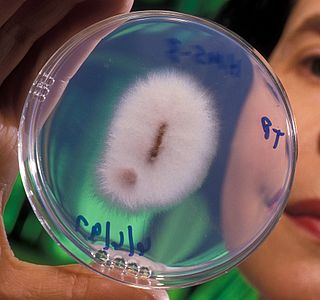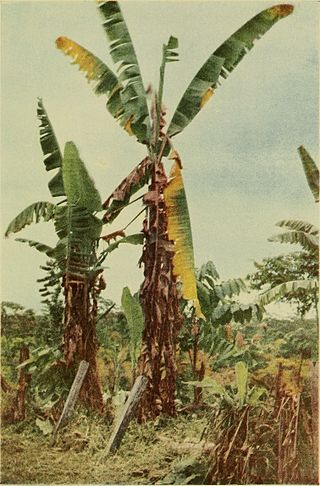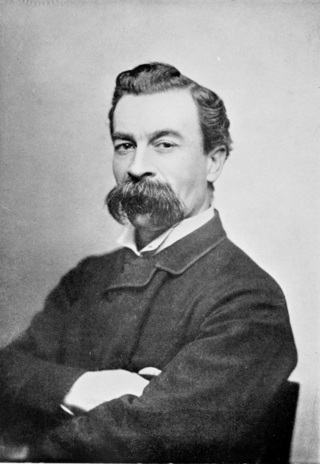Related Research Articles

Fusarium oxysporum, an ascomycete fungus, comprises all the species, varieties and forms recognized by Wollenweber and Reinking within an infrageneric grouping called section Elegans. It is part of the family Nectriaceae.

Black sigatoka is a leaf-spot disease of banana plants caused by the ascomycete fungus Mycosphaerella fijiensis (Morelet), also known as black leaf streak. It was discovered in 1963 and named for its similarities with yellow Sigatoka, which is caused by Mycosphaerella musicola (Mulder), which was itself named after the Sigatoka Valley in Fiji. In the same valley an outbreak of this disease reached epidemic proportions from 1912 to 1923.

Fusarium wilt is a common vascular wilt fungal disease, exhibiting symptoms similar to Verticillium wilt. This disease has been investigated extensively since the early years of this century. The pathogen that causes Fusarium wilt is Fusarium oxysporum. The species is further divided into formae speciales based on host plant.

Panama disease is a plant disease that infects banana plants. It is a wilting disease caused by the fungus Fusarium oxysporum f. sp. cubense (Foc). The pathogen is resistant to fungicides and its control is limited to phytosanitary measures.

Fusarium/fjuˈzɛəriəm/ (help·info) is a large genus of filamentous fungi, part of a group often referred to as hyphomycetes, widely distributed in soil and associated with plants. Most species are harmless saprobes, and are relatively abundant members of the soil microbial community. Some species produce mycotoxins in cereal crops that can affect human and animal health if they enter the food chain. The main toxins produced by these Fusarium species are fumonisins and trichothecenes. Despite most species apparently being harmless, some Fusarium species and subspecific groups are among the most important fungal pathogens of plants and animals.

Harry Marshall Ward, FRS,, was a British botanist, mycologist, and plant pathologist. He was one of the first scientists to study physiological plant pathology

Leptosphaeria sacchari is a plant pathogenic fungus which causes a disease called ring spot on Saccharum officinarum. This species was originally described in 1890 by Kruger and in 1892 by Van Breda de Haan after it was discovered in the Dominican Republic. L. sacchari is the applied name, whereas Epicoccum sorghinum is the accepted name.

Henry Luke Bolley was an American botanist and plant pathologist known for his work that led to the control or eradication of several major crop diseases. He was also a pioneering college football player and coach.

Paul Iselin Wellman was an American journalist, popular history and novel writer, and screenwriter, known for his books of the Wild West: Kansas, Oklahoma, Great Plains. Hollywood movies Cheyenne (1947) with Jane Wyman, The Walls of Jericho (1948) with Kirk Douglas, The Iron Mistress (1952) with Alan Ladd as Jim Bowie, Jubal (1956) with Ernest Borgnine and Rod Steiger, and The Comancheros (1961) with John Wayne and Lee Marvin are based on Wellman novels.

Carlos Eugenio Chardón Palacios, D.Sc., D.Litt, was the first Puerto Rican mycologist, a high-ranking official in government on agriculture during the 1920s, the first Puerto Rican appointed as Chancellor of the University of Puerto Rico (1931–1935), and the head of the Puerto Rico Reconstruction Administration in the mid-to late 1930s during the Great Depression. He was also known as "the Father of Mycology in Puerto Rico". He discovered that the aphid "Aphis maidis" was the vector of the sugar cane Mosaic virus. Mosaic viruses are plant viruses.

Fusarium oxysporum f. sp. cubensePronunciation (help·info) is a fungal plant pathogen that causes Panama disease of banana, also known as fusarium wilt of banana. The fungi and the related disease are responsible for widespread pressure on banana growing regions, destroying the economic viability of several commercially important banana varieties.
Wellman is an English surname. Notable people with the surname include:
Plant pathology has developed from antiquity, but scientific study began in the Early modern period and developed in the 19th century.
Frederick Creighton Wellman was an American physician specialising in tropical medicine, scientist, author, playwright, teacher, artist and engineer. As an author, he wrote under the pseudonyms Cyril Kay-Scott and Richard Irving Carson. His colorful life led to the epithet "the Casanova of Tropical Medicine".
Harold Corby Kistler is an American Adjunct Professor of biology and plant pathology at the University of Minnesota and a fellow of the American Phytopathological Society and the American Association for the Advancement of Science.
Kenneth Frank Baker was an American phytopathologist. In his early career he held a number of positions with the United States Forest Service and United States Department of Agriculture. Following a three-year period in Hawaii researching pineapple pathogens, he accepted a position at the University of California, Los Angeles, where he remained for twenty-one years. He was elected as a fellow of the American Association for the Advancement of Science in 1950 and as a fellow of the American Phytopathological Society in 1969. Additionally, he served as the editor of the Annual Review of Phytopathology for five years.
Robert James Cook is an American phytopathologist. He is best known for his work on soil-borne pathogens affecting wheat. He is the recipient of a Guggenheim Fellowship and the Wolf Prize in Agriculture and is a member of the National Academy of Sciences.
Robert Harry Stover was a Canadian-Honduran phytopathologist specializing in Musa crops and their fungal diseases.
Frederick Wellman may refer to:
Frank Lincoln Stevens was an American mycologist and phytopathologist. He gained an international reputation as one of the preeminent mycologists.
References
- ↑ Pierre Buekens (2012). "From Hygiene and Tropical Medicine to Global Health". American Journal of Epidemiology. 176 (Supplement 7): S1–S3. doi: 10.1093/aje/kws253 . PMID 23035133.
- 1 2 3 Eddie Echandi. "Frederick Lovejoy Wellman 1897-1994" (PDF). The American Phytopathological Society. Retrieved 6 May 2022.
- 1 2 3 4 5 "Frederick L. Wellman Papers 1915-1981". NC State University Libraries. Retrieved 6 May 2022.
- ↑ "Wellman, Frederick Lovejoy 1897-". WorldCat Identities. Retrieved 6 May 2022.
- ↑ "Manly Wade Wellman". Fantastic Fiction. Retrieved 6 May 2022.
- ↑ "Paul Wellman". Map of Kansas Literature. Retrieved 6 May 2022.
- ↑ Catalog of Copyright Entries. Third Series: 1973: January-June. Library of Congress Copyright Office. 1975.
- ↑ International Plant Names Index. Wellman.